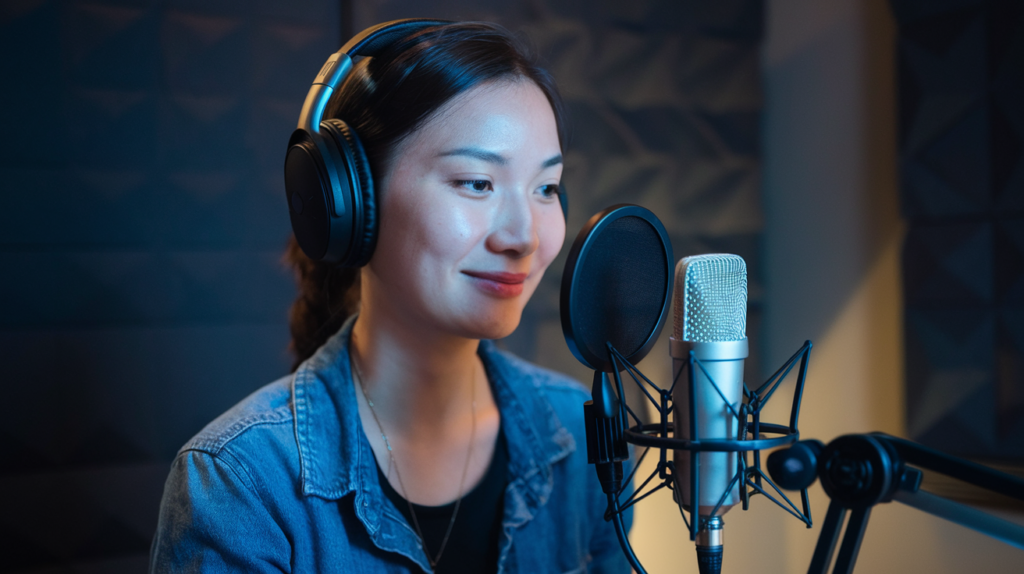Key Takeaways
- Understanding Chinese Video Transcription: It involves converting spoken content into written text, aiding accessibility and enhancing viewer engagement through accurate representation of dialogues.
- Importance of Accessibility: Transcriptions make videos inclusive for hard-of-hearing individuals and non-native speakers, improving search engine visibility and broadening audience reach.
- Tools for Efficiency: Utilize automatic transcription software like Google Cloud Speech-to-Text or manual techniques to ensure accuracy in capturing the nuances of different Chinese dialects.
- Systematic Approach: Follow a structured process including preparation, transcription, editing, and proofreading to create high-quality transcripts that effectively convey your message.
- Best Practices for Quality: Ensure clear audio, incorporate timestamps, edit thoroughly, seek feedback from native speakers, and maintain contextual clarity to enhance overall transcription quality.
- Collaboration with Professionals: Engaging skilled voice talent can significantly elevate the emotional impact and clarity of your content by providing compelling voiceovers.
Ever wondered how to accurately transcribe Chinese videos? Whether you’re a content creator, a student, or just someone looking to understand the language better, mastering video transcription can feel daunting. But don’t worry; this guide will break it down for you.
Overview Of Chinese Video Transcription
Chinese video transcription involves converting spoken content from videos into written text. This process serves various purposes, including accessibility for the hearing impaired, creating subtitles for international audiences, and enhancing search engine optimization (SEO) for online content.
Transcribing Chinese videos can be challenging due to factors like diverse dialects, tonal nuances, and regional accents. It’s essential to have a solid understanding of the language’s intricacies. Accurate transcription ensures that messages are conveyed correctly and can significantly impact viewer engagement.
When considering transcription services, think about how voiceovers enhance your video’s impact. Quality voiceover talent can bring scripts to life, adding emotion and clarity that written text alone may not achieve. The synergy between accurate transcription and compelling voiceovers creates engaging content that resonates with your audience.
Utilizing professional voice artists or actors adds another layer of quality to your project. These individuals possess the skills necessary to deliver clear and dynamic performances tailored to your specific needs. Collaborating with professionals ensures that both the transcription process and final product meet high standards of excellence.
Effective Chinese video transcription requires attention to detail while complementing it with skilled voiceover work. By focusing on both aspects, you elevate your content’s overall quality and reach a broader audience effectively.
Importance Of Video Transcription
Video transcription plays a crucial role in enhancing the overall effectiveness of your content. It transforms spoken language into written text, making videos more accessible and engaging for a wider audience.
Accessibility And Inclusivity
Transcription ensures that everyone can enjoy your video content, regardless of their hearing abilities. By providing accurate text representation, you cater to hard-of-hearing individuals and non-native speakers who may struggle with auditory comprehension. Including subtitles or captions derived from transcriptions makes your videos inclusive and user-friendly. Plus, search engines favor accessible content, boosting your visibility online.
Language Learning And Education
Transcribing videos supports language learners by offering them a valuable resource for studying vocabulary and pronunciation. When students read along while listening to native speakers, they grasp tonal nuances and dialect variations better. This approach fosters deeper understanding and retention of language skills. You can leverage transcriptions as educational tools in classrooms or online courses, enriching the learning experience for all participants.
Focusing on transcription not only elevates the quality of your video content but also broadens its reach and impact across diverse audiences.
Tools For Chinese Video Transcription
Transcribing Chinese videos efficiently requires the right tools. From automatic software to manual techniques, you can choose what fits your needs best.
Automatic Transcription Software
Automatic transcription software simplifies the process. These tools use advanced algorithms to convert spoken content into text quickly and accurately. Popular options include:
- Speech Recognition Solutions: Platforms like Google Cloud Speech-to-Text or IBM Watson offer robust speech recognition capabilities tailored for Mandarin and other dialects.
- AI-Powered Tools: Services such as Otter.ai and Rev utilize AI technology for fast transcriptions that often require minimal editing.
- Integrated Video Editors: Some video editing programs come with built-in transcription features, allowing seamless integration of transcripts during the editing process.
These tools not only save time but also enhance accessibility by providing quick captions or subtitles for your audience.
Manual Transcription Techniques
Manual transcription remains a valuable method, especially when precision is vital. Here are effective approaches:
- Listening and Typing: Play segments of the video repeatedly while typing out dialogues. This method ensures accuracy in capturing tonal nuances.
- Using Playback Controls: Take advantage of playback speed controls to slow down complex sections, making it easier to catch each word clearly.
- Time Stamping: Include timestamps at regular intervals or scene changes. Timestamps help viewers locate specific parts easily when using subtitles.
Employing these techniques can improve your understanding of regional accents and dialect variations in Chinese, ultimately enhancing the quality of your content.
By leveraging both automatic software and manual techniques, you can achieve high-quality transcriptions that resonate with diverse audiences while ensuring clarity and engagement in your messaging.
Steps To Transcribe Chinese Videos
Transcribing Chinese videos involves a systematic approach to ensure accuracy and quality. Follow these steps to streamline the process.
Preparing The Video Content
Start by gathering all necessary video content. Ensure your video is clear, with minimal background noise. High-quality audio simplifies transcription. If your video includes multiple speakers or accents, note these details ahead of time for better context during transcription. Familiarize yourself with the video’s subject matter; this knowledge aids in understanding nuances and specific terminology.
Transcribing Audio To Text
Choose between automatic software or manual techniques for transcribing audio to text. Automatic tools like Google Cloud Speech-to-Text provide quick results but may struggle with dialects or tonal variations common in Chinese languages. Manual transcription offers greater control over accuracy, allowing you to pause and rewind as needed. Listen carefully and type out what you hear, ensuring you capture every word accurately. Use timestamps if necessary, especially when dealing with longer segments or dialogues that switch between speakers.
Editing And Proofreading
Once you’ve completed the initial transcription, editing becomes crucial. Review your document for errors and inconsistencies—check spelling, grammar, and punctuation while ensuring proper formatting for readability. Read through the transcript alongside the video to catch any missed phrases or misinterpretations. Consider seeking feedback from someone fluent in Chinese; their insights can enhance clarity and precision significantly.
By following these steps diligently, you’ll create accurate transcripts that effectively convey your message while engaging diverse audiences through thoughtful presentation.
Best Practices For Effective Transcription
Transcribing Chinese videos effectively requires attention to detail and an understanding of the language’s nuances. Here are some best practices to enhance your transcription process:
- Ensure Clear Audio: Start with high-quality audio. If the sound is unclear, it complicates transcription. Choose videos recorded in quiet environments or adjust audio settings for clarity.
- Familiarize Yourself with Dialects: Recognize that Chinese has multiple dialects, each with unique tonal qualities. Understanding these differences helps capture accurate meanings in your transcripts.
- Use Playback Controls: Leverage playback features such as pause and rewind to catch every word accurately. Slowing down the video can also be useful for complex phrases or difficult accents.
- Incorporate Time Stamping: Adding time stamps makes it easier to reference specific sections later, especially when editing or syncing text with visuals, enhancing overall accessibility.
- Edit Thoroughly: After completing your initial transcription, review it carefully for errors and inconsistencies. Editing ensures clarity and accuracy in conveying the message intended by the speaker.
- Seek Feedback: Sharing drafts with colleagues or native speakers can provide insights into potential improvements you might overlook.
- Utilize Professional Voice Talent: Collaborating with a skilled voice artist enhances content delivery through emotive interpretations of your script, making it resonate more with viewers.
- Focus on Contextual Clarity: Maintain awareness of cultural references and context within conversations; this knowledge aids in producing a transcript that aligns well with audience expectations.
- Stay Consistent With Terminology: Use consistent terminology throughout transcripts, particularly for industry-specific jargon, ensuring coherence across all content pieces.
- Test Output Format Compatibility: Ensure that your final transcript format works well across various platforms where audiences access video content; compatibility contributes significantly to user experience.
By following these practices diligently, you not only improve transcription quality but also create a strong foundation for effective communication through voiceovers and other multimedia elements in your projects.
Conclusion
Mastering Chinese video transcription can greatly enhance your content’s reach and effectiveness. By leveraging both automatic tools and manual techniques, you can create accurate transcripts that cater to diverse audiences. This process not only boosts accessibility but also enriches the viewer experience.
Focusing on clarity and precision in transcription sets the stage for impactful communication. Don’t overlook the importance of professional voiceovers to elevate your message further. With these strategies in hand, you’re well-equipped to engage a wider audience and improve your overall content quality. Embrace these practices to ensure your videos resonate powerfully with viewers everywhere.
Frequently Asked Questions
What is video transcription?
Video transcription is the process of converting spoken content from a video into written text. This can be useful for creating subtitles, improving accessibility, and enhancing search engine optimization (SEO).
Why is transcribing Chinese videos challenging?
Transcribing Chinese videos can be difficult due to diverse dialects, tonal nuances, and regional accents. Understanding these intricacies is essential for accurate messaging and effective viewer engagement.
How does transcription improve accessibility?
Transcription makes video content accessible to hard-of-hearing individuals and non-native speakers by providing an accurate text representation. This inclusivity broadens audience reach and improves online visibility.
What tools can help with Chinese video transcription?
Tools like Google Cloud Speech-to-Text and AI-powered software such as Otter.ai assist in automatic transcription. Manual techniques, including listening closely and using playback controls, also enhance accuracy.
What are some best practices for video transcription?
Best practices include ensuring clear audio quality, familiarizing oneself with dialects, incorporating time stamping for easier reference, thorough editing for clarity, and seeking feedback from native speakers or colleagues.
Why should I consider professional voice talent?
Collaborating with professional voice artists enhances the emotional impact and clarity of your content. Quality voiceovers combined with accurate transcripts create more engaging videos that resonate with audiences.
How does transcription support language learners?
Transcription provides valuable resources for studying vocabulary and pronunciation. It promotes a deeper understanding of tonal nuances while helping learners engage effectively with the language’s complexities.
What steps should I follow when transcribing a Chinese video?
Begin by preparing the content for clear audio. Choose between automatic software or manual methods based on your needs. After initial transcription, meticulously edit and proofread to ensure accuracy before finalizing your transcript.







